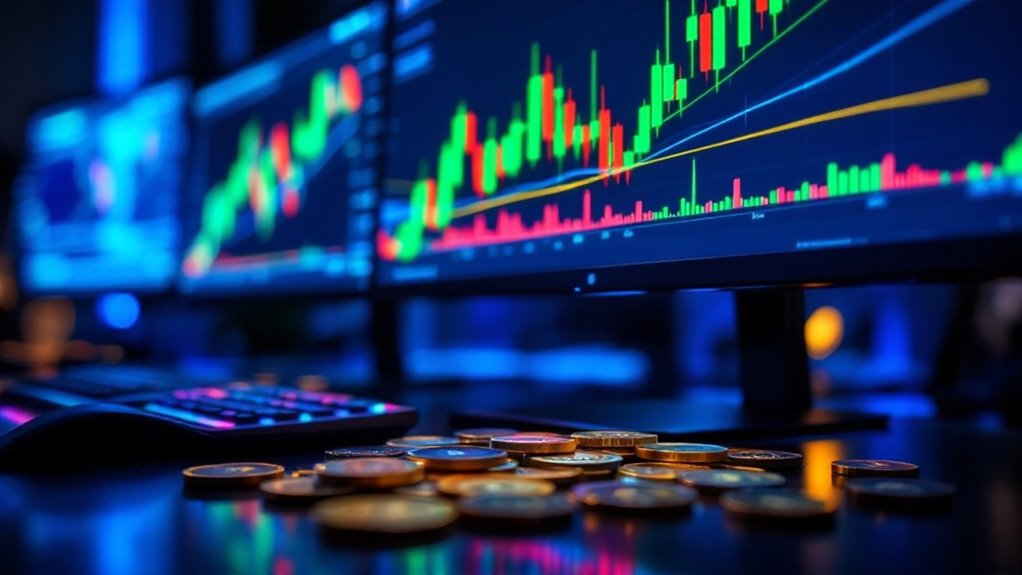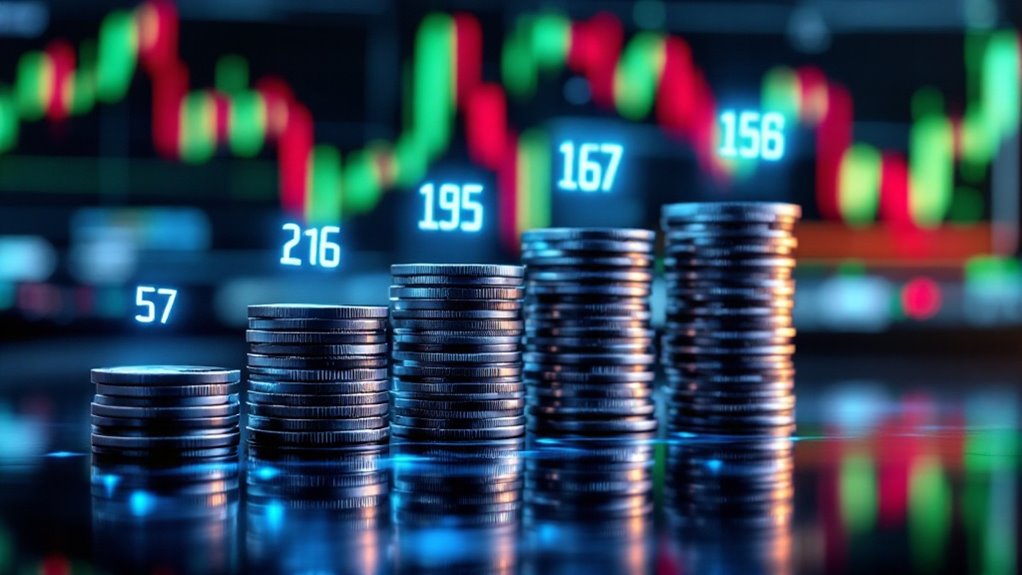MemeCoinCook.com serves up spicy crypto memes and info for entertainment only—this ain’t financial, investment, legal, or professional advice! Whipped up with AI flair, our content might have some half-baked bits, so DYOR before you dive into the crypto pot. NFA, folks—we’re just tossing out ideas, not guarantees. We make no claims about the accuracy, legality, or tastiness of our posts. Sip our content at your own risk! Check our Terms of Use for the full recipe.

What Is Volume in Crypto?
Trading volume in crypto shows how much of a cryptocurrency gets bought and sold over 24 hours. Think of it as a popularity meter—high volume means lots of traders are interested, while low volume suggests fewer people care. Volume gets measured in crypto units (like 100 BTC) or dollar amounts ($5 million). Higher volume typically means better liquidity and stronger price trends. This isn’t financial advice—trade at your own risk. Discover how volume patterns can sharpen your trading game.
Understanding Trading Volume in Cryptocurrency Markets

Trading volume in cryptocurrency markets works like a popularity meter for digital assets. Think of it as counting how many times people high-five each other at a party—more high-fives mean more action.
What Is Trading Volume?
Trading volume represents the total amount of crypto traded within a specific timeframe, usually 24 hours. It’s measured in either crypto units (like 1,000 BTC) or dollar values ($50 million). Volume serves as a proxy for sentiment, revealing how investors truly feel about a cryptocurrency’s prospects.
Trading volume counts every crypto transaction over time—like keeping score of market activity in Bitcoin or dollars.
Why Volume Matters
- Market Activity: Higher volume = more traders actively buying and selling
- Liquidity: Makes it easier to trade without causing price swings
- Trend Strength: Big price moves with high volume are more trustworthy
Low trading volumes can indicate weak price support, suggesting that current price levels might be vulnerable to sudden drops.
When Bitcoin’s volume suddenly spikes, it’s like everyone deciding to trade at once. During Bitcoin’s historic rally in 2017, the cryptocurrency’s price surge to all-time highs was accompanied by massive volume increases, demonstrating how heightened market interest translates into trading activity.
This isn’t financial advice—trade at your own risk.
How Volume Impacts Price Movements and Market Dynamics
When trading volume shifts dramatically in crypto markets, price movements often follow like dominoes falling in sequence. High volume acts as a price stabilizer, allowing large trades without causing massive swings. It’s like having a deep pool—you can jump in without splashing everyone nearby.
Key Volume-Price Relationships:
- Rising volume confirms strong price trends (up or down)
- Low volume = higher volatility and wider spreads
- Volume spikes often signal major momentum shifts
- Price moves without volume? Trend might be weakening
Think of volume as the market’s heartbeat. When it pulses strongly, prices move with confidence. When it’s quiet, even small trades can push prices around like a leaf in the wind. Research shows that Bitcoin’s price-volume relationship strengthened significantly post-2019, coinciding with increased regulatory oversight and market maturity. Studies have found that negative price shocks lead to negative volume shocks, demonstrating how market sentiment cascades through trading activity. Understanding volume dynamics becomes even more critical when considering advanced DeFi strategies like yield farming, where liquidity provision directly impacts trading volume and market efficiency.
*This isn’t financial advice—trade at your own risk.*
Reading and Analyzing Volume Data for Better Trading Decisions
Savvy traders don’t just watch prices dance across their screens—they study the volume choreography behind every move.
Key Volume Reading Techniques
- Volume spikes: These sudden jumps often signal major market shifts coming your way. Watch for news-triggered spikes that validate genuine investor interest versus potential manipulation.
- Volume indicators: Tools that transform raw data into visual patterns traders can actually understand. The Money Flow Index measures money flow in and out of a cryptocurrency, helping identify overbought or oversold conditions.
- Order book depth: Shows how many buyers and sellers are waiting at different price levels. On decentralized exchanges, liquidity pools provide the depth needed for smooth trading without traditional order books.
Advanced Analysis Methods
Volume Profile reveals where most trading happens, highlighting essential support and resistance zones.
Smart traders correlate volume patterns with price movements to spot genuine trends versus fake-outs. They analyze on-chain volume too—high numbers suggest real network adoption, not just speculation.
Remember: Some exchanges inflate volume through wash trading. Stick to reputable platforms.
*This isn’t financial advice—trade at your own risk.*
Frequently Asked Questions
How Is Crypto Volume Different From Traditional Stock Market Volume?
Crypto volume differs from stock market volume in several ways.
Crypto markets trade 24/7, unlike stocks’ limited hours. They show higher volatility with smaller volumes causing bigger price swings.
Crypto lacks institutional depth, making liquidity lower than traditional markets. Volume manipulation happens more frequently in crypto through wash trading.
Stock markets have stricter regulations and reporting standards.
Crypto volumes can spike dramatically during hype cycles, creating FOMO-driven surges.
*This isn’t financial advice—trade at your own risk.*
Which Exchanges Have the Most Reliable Volume Reporting Standards?
Several major exchanges maintain trustworthy volume reporting through strict standards and transparency measures.
- Binance – Market leader with 38% share, consistently audited
- Coinbase – Third-party verified, highly transparent reporting
- Kraken – Strong security focus, regulatory compliance
- Bitfinex – Robust auditing practices
- Huobi – Real-time updates, accurate data
These platforms prioritize transparency and follow regulatory requirements.
No sketchy business here.
*This isn’t financial advice—trade at your own risk.*
Can Volume Data Be Manipulated, and How Can Traders Identify Fake Volume?
Like mirages in a desert, fake volume tricks thirsty traders into seeing water where none exists.
Spotting Manipulation:
- Watch for volume spikes without news—red flag alert
- Same wallets trading repeatedly? That’s wash trading shenanigans
- Price pumps with aggressive social media hype spell trouble
Detection Tools:
- Compare volumes across exchanges
- Check blockchain transaction patterns
- Trust regulated platforms over sketchy ones
Smart traders stay skeptical when numbers seem too good.
*This isn’t financial advice—trade at your own risk.*
What Are the Best Volume Indicators for Day Trading Cryptocurrencies?
Successful day traders rely on several key volume indicators to navigate crypto markets effectively.
- On-Balance Volume (OBV): Tracks cumulative buying/selling pressure to predict price movements.
- Relative Strength Index (RSI): Identifies overbought/oversold conditions when combined with volume.
- Bollinger Bands: Signals volatility and potential breakouts.
- Moving Averages: Confirms trends and support levels.
These tools help traders spot opportunities and avoid getting “rekt.”
*This isn’t financial advice—trade at your own risk.*
How Does Volume Affect Cryptocurrency Mining and Network Hash Rates?
When trading volume increases, crypto prices often rise too. This makes mining more profitable, attracting more miners to the network.
The Mining Cycle:
- Higher prices = more miners join
- More miners = increased hash rate
- Increased hash rate = more electricity used
Think of it like a gold rush—when gold prices spike, more people start digging. Same energy.
*This isn’t financial advice—trade at your own risk.*
Conclusion
Like a crypto market’s heartbeat, volume reveals the true health of any trading pair. Smart traders know that price without volume is just noise. They watch for volume spikes, analyze patterns, and make informed decisions accordingly.
Understanding volume transforms anyone from a casual hodler into a more sophisticated market participant. It’s one fundamental tool that separates lucky guesses from educated trades.
*This isn’t financial advice—trade at your own risk.*



